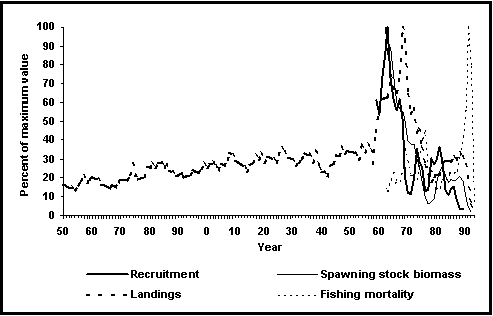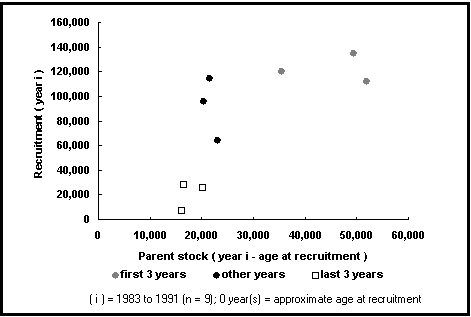Recruitment fluctuations and their causes represent one of the main areas of research in fisheries science, which is not surprising since it is these fluctuations which determine the annual catch levels of fisheries.
Precise prediction of future recruitment is not possible. However, broad generalizations are possible (e.g., that depleted stocks produce fewer recruits than healthy stocks, a non-trivial result). The more recruitment time series are available from various parts of the world, the more precise and reliable will the generalizations be.
Thus, we were delighted when R.A. Myers offered to incorporate into FishBase the comprehensive database of recruitment time series and related information he and his former colleagues at the North West Atlantic Fisheries Center, Science Branch, Department of Fisheries and Oceans, St. John’s, Canada, had painstakingly assembled (Myers et al. 1990, 1995). Pending a more comprehensive account by R.A. Myers (now with Dalhousie University, Halifax, Nova Scotia, Canada), the paragraphs below briefly describe the structure created to accommodate these data.
The RECRUITMENT window will first list, for a given species, the stocks for which a recruitment series (and associated series, if any) are available. Double-clicking on one such stock leads to the RECRUITMENT table proper.
The method used to derive a time series of recruitment (and related series) is shown through a multiple-choice field with the following entries:
direct counts;
catch/effort data;
electro-fishing;
mark-recapture;
SPA (VPA);
stock reconstruction;
research survey; and
see additional information.
Also presented are the age groups used for estimating fishery mortality, the recruitment lag, i.e., the age at recruitment, tr (in years), and the locality, together with the latitude/longitude of the midpoint of the stock’s range. Finally, the other components of the database supplied by R.A. Myers are shown in form of a concatenated memo field, with all non-empty entries following the (slightly expanded) column headings.
The recruitment time series data and, if available, the corresponding estimates of landings, spawning stock biomass and/or fishery mortality are shown when you click on the Graph or Table buttons. Note, however, that in the graphs, the series are expressed in relative units (each as percentage of its maximum value) (see Fig. 31). Click on the Table button for numeric data in absolute units.
A graph can also be accessed which allows comparing the variability of the available recruitment time series, while another graph (see Fig. 32) illustrates the relationship between parental stock size and subsequent recruitment.

Fig. 31. Time series of landings, spawning stock biomass, recruitment and fishing mortality of Atlantic cod (Gadus
morhua) around Newfoundland, Canada. Note how modern fisheries development, starting in the 1960s destroyed a
fishery that had previously been sustained for a very long time.

Fig. 32. Example of a relationship between recruitment and parental stock for Merluccius merluccius in
ICES VIIIc and IXa; note codes used to identify the start and the end of a series.
Presently, over 750 recruitment series are available for about 150 species. All updating will be through R.A. Myers, who should be contacted directly by users interested in contributing data (
Myers@phys.ocean.dal.ca).
You get to the RECRUITMENT Form by clicking on the Recruitment button in the POPULATION DYNAMICS window.
On the Internet, the RECRUIMENT table as well as the graphs are available if you click on the Recruitment link in the ‘More information’ section of the ‘Species Summary’ page. The original version of R.A. Myers’ series may also be downloaded from http://www.mscs.dal.ca/~myers/welcome.html.
We thank R.A. Myers and his colleagues for entrusting the FishBase Project with their valuable database.
Myers, R.A., W. Blanchard and K.R. Thompson. 1990. Summary of North Atlantic fish recruitment, 1942-1987. Can. Tech. Rep. Fish. Aquat. Sci. No. 1743.
Myers, R.A., J. Bridson and N.J. Barrowman. 1995. Summary of worldwide stock and recruitment data. Can. Tech. Rep. Fish. Aquat. Sci. No. 2024.
Daniel Pauly and Crispina Binohlan